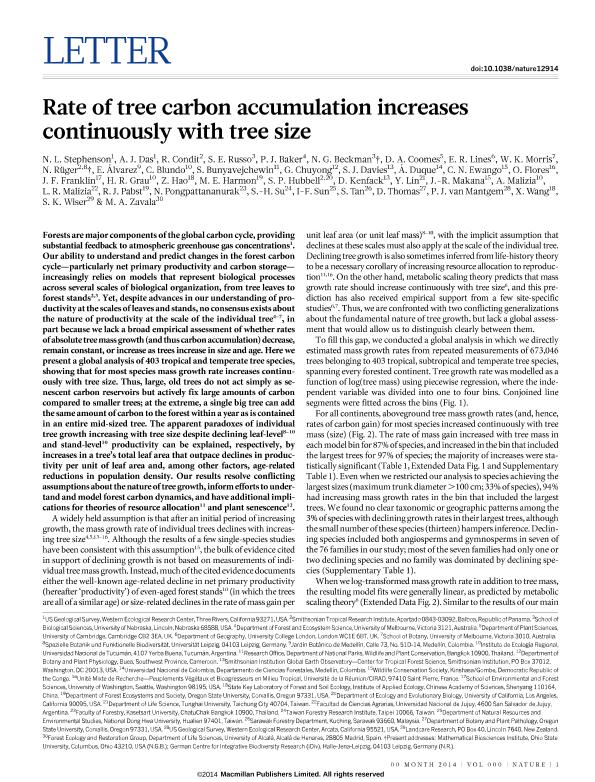Mostrar el registro sencillo del ítem
dc.contributor.author
Blundo, Cecilia Mabel

dc.contributor.author
Grau, Hector Ricardo

dc.contributor.author
Malizia, Agustina

dc.contributor.author
Malizia, Lucio Ricardo

dc.date.available
2017-02-08T21:22:29Z
dc.date.issued
2014-03
dc.identifier.citation
Blundo, Cecilia Mabel; Grau, Hector Ricardo; Malizia, Agustina; Malizia, Lucio Ricardo; Rate of tree carbon accumulation increases continuously with tree size; Nature Publishing Group; Nature; 507; 7490; 3-2014; 90-93
dc.identifier.issn
0028-0836
dc.identifier.uri
http://hdl.handle.net/11336/12757
dc.description.abstract
Forests are major components of the global carbon cycle, providing substantial feedback to atmospheric greenhouse gas concentrations. Our ability to understand and predict changes in the forest carbon cycle—particularly net primary productivity and carbon storage— increasingly relies on models that represent biological processes across several scales of biological organization, from tree leaves to forest stands. Yet, despite advances in our understanding of productivity at the scales of leaves and stands, no consensus exists about the nature of productivity at the scale of the individual tree, in part because we lack a broad empirical assessment of whether rates of absolute treemass growth (and thus carbon accumulation) decrease, remain constant, or increase as trees increase in size and age. Here we present a global analysis of 403 tropical and temperate tree species, showing that for most species mass growth rate increases continuously with tree size. Thus, large, old trees do not act simply as senescent carbon reservoirs but actively fix large amounts of carbon compared to smaller trees; at the extreme, a single big tree can add the same amount of carbon to the forest within a year as is contained in an entire mid-sized tree. The apparent paradoxes of individual tree growth increasing with tree size despite declining leaf-level and stand-level productivity can be explained, respectively, by increases in a tree’s total leaf area that outpace declines in productivity per unit of leaf area and, among other factors, age-related reductions in population density. Our results resolve conflicting assumptions about the nature of tree growth,inform efforts to undertand and model forest carbon dynamics, and have additional implications for theories of resource allocation and plant senescence.
dc.format
application/pdf
dc.language.iso
eng
dc.publisher
Nature Publishing Group

dc.rights
info:eu-repo/semantics/openAccess
dc.rights.uri
https://creativecommons.org/licenses/by-nc-sa/2.5/ar/
dc.subject
Carbon Accumulation
dc.subject
Tree Size
dc.subject
Ecology
dc.subject.classification
Ecología

dc.subject.classification
Ciencias Biológicas

dc.subject.classification
CIENCIAS NATURALES Y EXACTAS

dc.title
Rate of tree carbon accumulation increases continuously with tree size
dc.type
info:eu-repo/semantics/article
dc.type
info:ar-repo/semantics/artículo
dc.type
info:eu-repo/semantics/publishedVersion
dc.date.updated
2017-02-03T14:01:43Z
dc.identifier.eissn
1476-4687
dc.journal.volume
507
dc.journal.number
7490
dc.journal.pagination
90-93
dc.journal.pais
Reino Unido

dc.journal.ciudad
Londres
dc.description.fil
Fil: Blundo, Cecilia Mabel. Universidad Nacional de Tucumán. Facultad de Ciencias Naturales e Instituto Miguel Lillo. Instituto de Ecología Regional; Argentina. Consejo Nacional de Investigaciones Científicas y Técnicas; Argentina
dc.description.fil
Fil: Grau, Hector Ricardo. Universidad Nacional de Tucumán. Facultad de Ciencias Naturales e Instituto Miguel Lillo. Instituto de Ecología Regional; Argentina. Consejo Nacional de Investigaciones Científicas y Técnicas; Argentina
dc.description.fil
Fil: Malizia, Agustina. Universidad Nacional de Tucumán. Facultad de Ciencias Naturales e Instituto Miguel Lillo. Instituto de Ecología Regional; Argentina. Consejo Nacional de Investigaciones Científicas y Técnicas; Argentina
dc.description.fil
Fil: Malizia, L. R.. Universidad Nacional de Jujuy. Facultad de Ciencias Agrarias; Argentina
dc.journal.title
Nature

dc.relation.alternativeid
info:eu-repo/semantics/altIdentifier/doi/http://dx.doi.org/10.1038/nature12914
dc.relation.alternativeid
info:eu-repo/semantics/altIdentifier/url/http://www.nature.com/nature/journal/v507/n7490/full/nature12914.html
Archivos asociados
